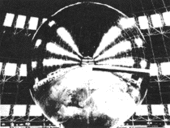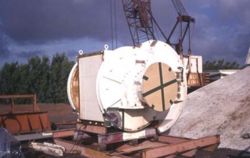Key FPQ-6 Mission Activity
- Antenna structure
- Tracking and Ranging
- Brief system details
- RCA Computer
- Key Q6 Mission Activity
- Research activity
- BDA, CRO & RCA: Q6 partners
- Other Q-6 tales
Back to Station Equipment
A full catalogue of Carnarvon FPQ-6 tracking would be a potted history of US space exploration - post Mercury. The following examples pinpoint highlights of Carnarvon’s radar activity in order of the first track in each group.
- Communications satellites
- Echo-2, a 'rigidized' 30.5m passive communications sphere, launched on 25 January 1964 was the first object in space tracked by Carnarvon (CRO). It was followed later that year by Syncom-3, the first truly synchronous communications satellite, on 19 August.
- The three communications satellites that followed were NASA’s vital communications links with its remote tracking stations. Intelsat-2A failed to reach a synchronous orbit but, before decaying, managed to relay several minutes of Down Under Comes Up Live - the very first TV transmission from Australia (Carnarvon) to England on 26 October 1966. Intelsat-2B followed on 11 January 1967 to become Pacific-1 – CRO’s communications satellite link to the US. Intelsat-2C on 23 March 1967 became Atlantic-1.
- SKYNET-1A, a UK military communications satellite, was successfully placed in synchronous orbit over the Indian Ocean on 22 November 1969. SKYNET-2A launched in January 1974 became lost and shortly after was discovered in a lower Earth orbit by the CRO FPQ-6; an orbit from which it could not be rescued.
- Telesat-A, a Canadian domestic communications satellite launched on 9 November 1972, failed to reach the correct orbit; nevertheless CRO FPQ-6, acquiring it a little behind schedule, was able to generate new tracking parameters to enable successful acquisitions by both Hawaii and Bermuda. The satellite was subsequently established in a successful synchronous orbit.
- By mid 1997, 535 domestic communications satellites had been launched. About 50 of these had been supported by CRO FPQ-6 before it ceased tracking in mid-1975.
- Apollo/Saturn
- On 29 Jan 1964 the Saturn-V launch vehicle designed to lift Apollo for its journey to the Moon orbited the Earth for the first time; it became CRO FPQ-6’s second track fifteen months before Carnarvon had even seen a Gemini spacecraft. The next Apollo mission supported was on 5 July 1966; four orbits of Apollo-2 driven by the Saturn-IVB after separation from the Saturn-V. Fifteen Apollo missions were to follow in due course with CRO FPQ-6 supporting every viewable opportunity for manned missions; not merely the early-orbit definition period.
- The Apollo-13 re-entry phase was the only Apollo mission for which its support bordered on critical; it had all three vehicles on view – the Command Module containing the three astronauts, the Service Module and the Lunar Module – the latter two now jettisoned. The Lunar Module was a key concern because it held the Apollo Lunar Surface Experimental Package (ALSEP) containing 3.9 Kg of radioactive plutonium in its power generator. NASA wanted to be sure the Lunar Module was on target for a non-contaminating splashdown in deep ocean waters well away from New Zealand. Naturally the CRO FPQ-6 crew was also delighted by the safe return of the three astronauts.
- Deep Space Network (DSN) support
- All DSN spacecraft needed to break free of Earth’s gravity on a very particular path to be sure of reaching their destination. CRO FPQ-6’s position and accuracy was a vital part of the tracking process. It meant that the first post-injection course correction could be sooner and more specific than it would be for a less accurate tracking system.
- CRO FPQ-6’s first productive track ever was three hours of data for Ranger-6, a DSN mission, on 30 January 1964, including the trans-lunar injection (TLI) phase. Ranger-6 televised photos of the Moon’s surface back to Earth. CRO followed with three more Ranger missions. Tracking of Ranger-8 on 28 July 1964 created a local distance record of 35,000 Km (nearly 22,000 miles); but with NASA noting that CRO’s FPQ-6 “... had skin-tracked the Ranger vehicle to 10,500 miles, the longest range precision tracking known to have been done without beacons."(Ref: Van Citters, G. W., “NASA Officials Praise M&SR Radars for Gemini 4 Tracking Performance” in 'RCA FAMILY', May-June 1965, Vol 8 No 3)
- Ken Anderson, ex FPQ-6 Site Engineer, comments, "I have difficulty understanding how the Ranger-8 track could have been that long. Even if the S/N was only 3 dB the RCS of the target would have had to be 45 dB above a metre square, that is about 40 times the physical dimensions of the largest dimensions of the Ranger vehicle. I wonder if we are seeing the result of some sort of plasma enhancement of the RCS due to the Van Allen belts-but I can't find any reference to such an effect. Very mysterious."
- CRO FPQ-6 supported Pioneer-A on 16 December 1965 by tracking through its transition into a heliocentric (Sun-centred) orbit; the first of six similar DSN Pioneer missions. They measured ‘particles and fields’ - solar wind, solar magnetic field and cosmic rays - at different distances out from the Sun.
- The DSN Surveyor ‘Lunar Lander’ missions landed on the Moon to take photos of the moonscape and to analyse soil samples. At the time they were probably the most interesting for CRO FPQ-6; a promise of the forthcoming manned lunar landings
- Surveyor-1, the first of seven ‘Lunar Lander’ missions, was launched on 30 May 1966; and stimulated rivalries between the tracking systems at Carnarvon. FPQ-6, as usual, tracked the spacecraft through the TLI phase and on towards the Moon. The Unified S-Band (USB) system destined to support Apollo at lunar distances, acquired the Ranger S-band signal by slaving to the FPQ-6 angles. There was some bitterness at FPQ-6 when Surveyor-1 went out of radar range; USB cheers sounded out on the intercom celebrating the fact that they were still locked onto the spacecraft. The pragmatic radar crew consoled themselves with the fact that it was merely the nature of USB technology rather than the skill of the USB crew.
- As it did for previous DSN missions, CRO FPQ-6 provided support for the TLI phases of the five Lunar Orbiter missions between August 1965 and August 1966. These orbited the Moon taking highly detailed photographs of potential Apollo landing sites. When each Lunar Orbiter had finished its task it was handed over to the USB network to refine ground tracking station positional accuracy prior to the first Apollo landing.
- No record has been found of support for the DSN Mariner missions to Mars and Venus though it is highly probable CRO FPQ-6 support was required as it was for the other DSN missions.
- By the time Apollo-8 reached for the Moon, CRO FPQ-6 had participated in at least 19 injections of DSN spacecraft onto trans-lunar or trans-planetary paths. Such events had become routine.
- Gemini/Agena
- The principal role of CRO was the Manned Space Flight Network (MSFN) support of the Gemini/Agena missions followed by the Apollo missions. For the first of many times, CRO FPQ-6 radar combined with the MSFN systems to track the unmanned Gemini-1 on 8 April 1964. CRO nearly lost the opportunity, less than two minutes to launch, due to a lightning strike cutting its ‘sole’ communications link with the rest of the world. The PMG with the help of Lillian O’Donoghue, Postmistress of Hamelin Pool, found an alternative route along an obsolete telephone line to Hamelin Pool and then along the ‘sheep station’ telegraph lines to Carnarvon Telephone Exchange. For several hours in the middle of the night, Lillian wrote down long strings of meaningless numbers (CRO pointing data) then dictated them to an operator at FPQ-6 patched through from the local telephone exchange. CRO passed its debut with flying colours.
- The first target-vehicle launch, Agena-6, was tense. The vehicle apparently blew up at the initiation of the first burn, but CRO radar was required to stay on watch for three hypothetical orbits in a futile attempt to spot it, or fragments of its explosion. From a tracking point of view, the CRO FPQ-6 support of the Gemini/Agena series was generally uncomplicated but busy; many of the orbital changes requiring precision tracking were scheduled to take place within view of CRO. After the Agena-6 failure, the unlaunched Gemini-6 was relabelled Gemini-6a and was launched on 15 December, shortly after Gemini-7 on 4 December 1965 to ensure the astronaut training program remained firmly on schedule. This gave the ground radars an exceptional workload with two manoeuvring manned spacecraft in close orbit.
- The early orbits of Gemini-11, the penultimate Gemini/Agena mission, were virtually a rehearsal for the first lunar ascent and rendezvous planned for Apollo-11. After the first orbit of Agena-11 was certified as ‘good’, Gemini-11 was launched and achieved rendezvous over CRO in its first orbit followed later by docking with Agena-11 before Gemini’s first orbit was complete. The prime objective of the mission now complete, the astronaut’s now used Agena-11 during orbit-26 to boost them to a then-record height of 1.368.9Km over North Western Australia to give CRO a very long and satisfying pass.
- WRESAT
- On 29 November 1967, Australia became the fourth nation to place a satellite into orbit. WRESAT (Weapons Research Establishment Satellite) was a logical extension of the HAD program which CRO FPQ-6 had supported in 1964. WRESAT was launched from Woomera across North West Australia into a retrograde polar orbit with FPQ-6 confirming that a good orbit was achieved and CRO GRRR, as part of STADAN, collecting 43.5 minutes of data on the first orbit.
- ’Orbiting Vehicle’ (OV) series
- US Air Force ‘Orbiting Vehicle’ OV1-20 and OV1-21 were launched on 7 August 1971 by the US Department of Defence (DoD) into retrograde polar orbits with each ejecting a low-altitude density sub-satellite: Cannonball-2 (OAR-901) and Musketball (OAR-907). The drag on these as they passed through the fringe of the Earth’s atmosphere required extra radar tracking to redefine their orbital parameters. CRO FPQ-6 was called upon to help, following negotiation with the Australian Government; given assurance that these DoD satellites were entirely scientific in accordance with the NASA charter.
- Good technical work by CRO FPQ-6 led to a lasting US Air Force Network Control requirement for CRO to provide pointing data to the OV network for other satellites in the OV series. But ‘permission’ was still required for each new mission.
- Skylab
- The Skylab Laboratory, SL-1, was launched on 14 May 1973. It reached a good orbit but with the suspected solar-array problems; CRO telemetry confirmed the loss of the workshop sun-shade and one of the two solar-arrays with the other only partially opened. The workshop was ‘rescued’ by Skylab Visit-1, SL-2, on 25 May 1973 with the astronauts levering free the jammed solar-array to restore power to the workshop and erecting a parasol sunshade to keep it cool. Visit-1 completed all scheduled tasks and was followed by a full schedule for both Visit-2, SL-3, and Visit-3, SL-4 – in all 2,476 manned orbits. As with other manned missions, CRO FPQ-6 supported the full quota of manned passes as well as many others before and between the manned phases.
The end of CRO FPQ-6
In March 1974, shortly after the completion of the Skylab Missions, with just over 10 years of tracking, the radar went on ‘hot standby’. There were no further calls for precision tracking other than occasional tracks to ensure the radar was still functioning. On 4 October 1974, the whole station ceased operations except for one mission for which FPQ-6 radar was not required.
Dismantling of FPQ-6 started in December 1974. As late as 1978, the FPQ-6 antenna remained in storage in the US because NASA could not find the funds to re-erect it. Tragically, it may still lie on a back lot somewhere. [Bob Hocking email to PD - 01 March 2007]
#top




